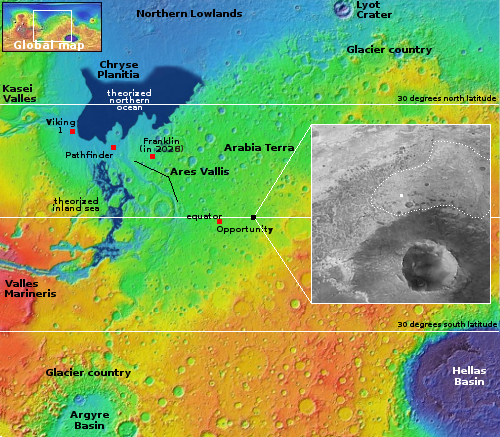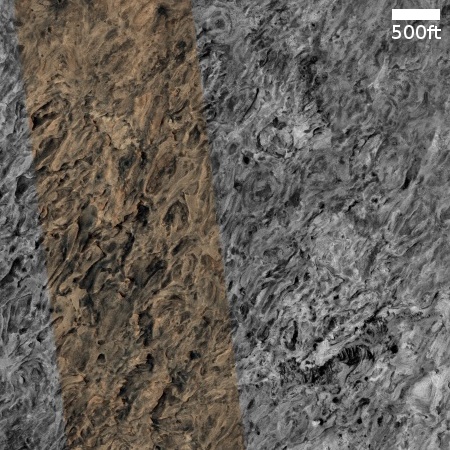Etched terrain on Mars
Today’s cool image is another example of what I call a “What the heck!” image. The picture to the right, simply cropped to post here, was taken on September 22, 2024 by the high resolution camera on Mars Reconnaissance Orbiter (MRO).
It shows what the scientists label as “etched terrain,” an incredibly twisted and eroded landscape that to me actually defies description. In trying to research what scientists have learned and theorized about this terrain, it appears they think it is material that flowed over older terrain (thus its lack of many craters) that was subsequently eroded by later processes.
Why it eroded so strangely however is not really understood. It could have been caused by near-surface ice sublimated to the surface and thus causing many breaks, but since this terrain is located right on the equator in the dry tropics, it is a very long time since water was present here.

The black dot on the equator marks the location, about 370 miles east of where the rover Opportunity roamed. The dotted white line in the inset marks the perimeter of this etched terrain, which extends many miles in all directions from the small area in the picture above. It also seems somehow related to the nine-mile-wide crater immediately to the south. That crater has an ejector splash apron, which the etched terrain abuts. Furthermore, the etched terrain actually extends beyond my dotted line, though its ridges and hollows beyond tend to be larger in scale.
What remains unknown is whether the etched terrain was there already when the impact occurred that created that crater, or whether it was formed due to that impact. Based on the rough guesses by scientists, I suspect the former. The impact covered some of that etched terrain.
Why it formed so strangely however remains a mystery.
On Christmas Eve 1968 three Americans became the first humans to visit another world. What they did to celebrate was unexpected and profound, and will be remembered throughout all human history. Genesis: the Story of Apollo 8, Robert Zimmerman's classic history of humanity's first journey to another world, tells that story, and it is now available as both an ebook and an audiobook, both with a foreword by Valerie Anders and a new introduction by Robert Zimmerman.
The print edition can be purchased at Amazon or from any other book seller. If you want an autographed copy the price is $60 for the hardback and $45 for the paperback, plus $8 shipping for each. Go here for purchasing details. The ebook is available everywhere for $5.99 (before discount) at amazon, or direct from my ebook publisher, ebookit. If you buy it from ebookit you don't support the big tech companies and the author gets a bigger cut much sooner.
The audiobook is also available at all these vendors, and is also free with a 30-day trial membership to Audible.
"Not simply about one mission, [Genesis] is also the history of America's quest for the moon... Zimmerman has done a masterful job of tying disparate events together into a solid account of one of America's greatest human triumphs."--San Antonio Express-News
Today’s cool image is another example of what I call a “What the heck!” image. The picture to the right, simply cropped to post here, was taken on September 22, 2024 by the high resolution camera on Mars Reconnaissance Orbiter (MRO).
It shows what the scientists label as “etched terrain,” an incredibly twisted and eroded landscape that to me actually defies description. In trying to research what scientists have learned and theorized about this terrain, it appears they think it is material that flowed over older terrain (thus its lack of many craters) that was subsequently eroded by later processes.
Why it eroded so strangely however is not really understood. It could have been caused by near-surface ice sublimated to the surface and thus causing many breaks, but since this terrain is located right on the equator in the dry tropics, it is a very long time since water was present here.

The black dot on the equator marks the location, about 370 miles east of where the rover Opportunity roamed. The dotted white line in the inset marks the perimeter of this etched terrain, which extends many miles in all directions from the small area in the picture above. It also seems somehow related to the nine-mile-wide crater immediately to the south. That crater has an ejector splash apron, which the etched terrain abuts. Furthermore, the etched terrain actually extends beyond my dotted line, though its ridges and hollows beyond tend to be larger in scale.
What remains unknown is whether the etched terrain was there already when the impact occurred that created that crater, or whether it was formed due to that impact. Based on the rough guesses by scientists, I suspect the former. The impact covered some of that etched terrain.
Why it formed so strangely however remains a mystery.
On Christmas Eve 1968 three Americans became the first humans to visit another world. What they did to celebrate was unexpected and profound, and will be remembered throughout all human history. Genesis: the Story of Apollo 8, Robert Zimmerman's classic history of humanity's first journey to another world, tells that story, and it is now available as both an ebook and an audiobook, both with a foreword by Valerie Anders and a new introduction by Robert Zimmerman.
The print edition can be purchased at Amazon or from any other book seller. If you want an autographed copy the price is $60 for the hardback and $45 for the paperback, plus $8 shipping for each. Go here for purchasing details. The ebook is available everywhere for $5.99 (before discount) at amazon, or direct from my ebook publisher, ebookit. If you buy it from ebookit you don't support the big tech companies and the author gets a bigger cut much sooner.
The audiobook is also available at all these vendors, and is also free with a 30-day trial membership to Audible.
"Not simply about one mission, [Genesis] is also the history of America's quest for the moon... Zimmerman has done a masterful job of tying disparate events together into a solid account of one of America's greatest human triumphs."--San Antonio Express-News



Looks like differential weathering (by wind) of fairly soft material. That material had enough lamination to provide very slightly more and less susceptible strata with respect to wind erosion. Note the very subtle direction of these features (upper right to lower left) indicating prevailing wind direction.